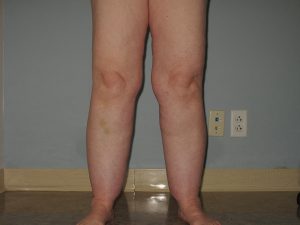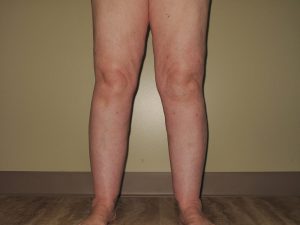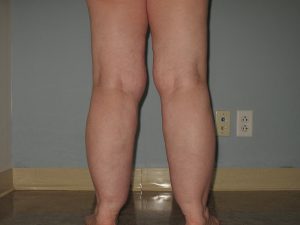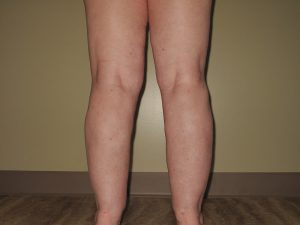Lipedema is a chronic progressive congenital fat storage disorder that can affect the quality of life and health of the person with the disease. Some of the symptoms caused by lipedema—heaviness, pain, and secondary swelling—can be alleviated, at least in part, by conservative treatments such as compression or short stretch wraps, manual lymph drainage, and medication. However, there are several limitations to conservative treatments.




Front of Calf Lipedema Lipo Treatment Before & After




Back of Calf Lipedema Lipo Treatment Before & After
Conservative treatments afford temporary relief while they are practiced, but the effect of conservative treatments is variable. Some individuals experience significant relief, while others experience only very limited relief. Additionally, conservative treatments are not able to redress all symptoms. For example, conservative treatments have little to no effect on the mobility problems that occur as a result of the abnormal accumulation of fat around the knees or thighs, and conservative therapy is not able to address psychological or social issues resulting from the disproportionate body shape. Lastly, conservative therapy, as far as we can tell, is unable to halt the progression of lipedema.
Liposuction Treatment for Lipedema
Unfortunately, there is no cure for lipedema. For many women, the most comprehensive way to treat the symptoms of lipedema is lymph-sparing liposuction. This surgical option is the only one that can remove the abnormal fat of lipedema; however, great care must be taken to spare lymphatic structures when performing liposuction. Although not all people with lipedema suffer swelling of the limbs, many have abnormal lymphatic function [Harwood DOI: 10.1046/j].
There are two specialized liposuction techniques that have been shown in studies to benefit individuals with lipedema: water-assisted and tumescent liposuction. In addition to the surgical equipment used, it is important to choose a surgeon with experience and one that is cautious when performing the surgery. These factors can have an important influence on the ability to not harm lymphatic flow and function.
Tumescent Liposuction or Water Assisted Liposuction
Microcannula tumescent liposuction, performed with great care to avoid lymphatic injury, was shown to significantly improve pain, mobility, and leg size [Rapprich: “Liposuction is an Effective Treatment for Lipedema Results of a Study with 25 Patients”]. After the fat tissue is infused with a tumescent solution to swell the fat cells and constrict vessels, 3mm microcannulas are used to remove the lipedema fat by suction. This surgical technique has been shown to achieve long-lasting improvement in symptoms.
Water Assisted Liposuction [WAL, Aqua Shape, or Body Jet Lipo] has also been shown to produce significant improvement of mobility, symptoms, and quality of life factors for individuals with lipedema. Water Assisted Liposuction is similar to tumescent liposuction; however, the tumescent solution is pressurized to dislodge or loosen the fat from its surrounding connective tissue and vessels.
In theory, the pressurized tumescent fluid should be gentler than traditional tumescent liposuction, but the final step for both requires a similarly shaped suction cannula. The ideal way to compare the relative safety and effectiveness of these two techniques would be a head-to-head study of both techniques where traditional tumescent liposuction using a micro-cannula lymph sparing technique was used on one leg and the WAL was used on the other leg. No head-to-head trial of the two techniques has been conducted.
At this time, I believe both techniques, in the proper hands, are safe and effective treatments for lipedema. The one caveat is to be sure the surgeon performing the liposuction has skill and experience to perform a lymph sparing technique of liposuction. We do know that traditional liposuction, without special care of the lymphatics or proper tumescent technique, can cause lymphatic damage and possibly worsen lipedema symptoms. [Hoffman Plast Reconstr Surg. 2004 Feb;113(2):718-24; discussion 725-6].
How to Decide if a Lymph Sparing Liposuction Technique is Right for You
Liposuction cannot cure lipedema; it can only provide fat reduction and symptom relief. Liposuction is not an appropriate option for everyone with lipedema. Like any surgical procedure, liposuction has risks, and not everyone is a good candidate for a liposuction procedure.
Although liposuction is generally safe in healthy individuals, it can have risks such as infection, bleeding, and trauma to the area. Post-operative swelling in the limbs after liposuction, which occurs with any liposuction procedure, is more prolonged in individuals with lipedema. The swelling actually gets worse for a couple of months before it gets better, and the full benefit may not be realized for six months to a year. Most patients with lipedema experience significant improvement of many or all of their symptoms; however, individual results can vary. Custom-fit compression garments, which are essential for the perioperative period, can be expensive and hard to find. It is impossible to remove all lipedema fat through liposuction. The percentage of the reduction of fat varies by the amount of fat in the area and the amount of fibrosis or nodularity of the area treated.
Although some people who have lipedema limited to only one specific area may need one procedure, most people undergo multiple liposuction procedures to address all the different areas affected by lipedema. The multiple liposuction procedures need to be staged, or separated, to be done safely. The timing of the procedures depends on multiple factors, including the clinical stage of lipedema in the patient, the amount fat of being removed, the patient’s health and mobility, and other logistical factors.
Lipedema is an inherited fat storage disease, and ideally, all of its treatments should be covered by medical insurance. The reality is that most medical insurance providers do not cover the cost of liposuction for the treatment of lipedema, and the few insurance providers that do cover the liposuction treatment cover only a portion of the cost. Another factor to consider is that most people must travel in order to get lipedema-specific liposuction. That means taking time off work, a helper/caregiver taking time off work to travel with you, and the expense of traveling and living for a while in another city.
For more information on Lipedema please visit FatDisorders.org for some valuable information.







